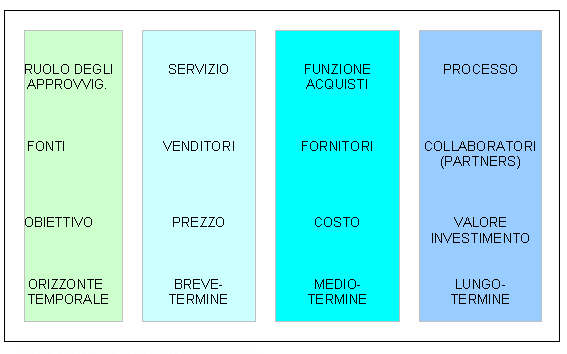
CHAPTER 1: THE EVOLUTION OF THE PURCHASES
1.1 Definition of "purchases" and "supplyings"
The technology has transformed world-wide the economic scene, marking a change speed that probably
will continue to along.
The development of the transports and the communications has provoked the increase of the markets is of the question that of
the offer to world-wide level, creating an only display window to the inside of which the competition is extremely high.
This has involved the modification of the strategies business and consequently an evolution of the field has been taken place with
the time also acquires.
Constant search of lessening of the costs is being gone towards one and trying to render them also most possible flexible,
containing fixed costs 5 to favor of variable costs 6 ,
for being able them therefore to adapt to the course of the transactions.
The fixed cost reduction involves, on one side the control of the total dimension of the organizations, eliminating those
structures that are not directly in relation with Core business or with the maintenance of know-how
the 7 and from the other the purchase from external organizations of the goods and services
previously produced to the inside (es. from organic fixed to a tantum job, from inner production of the services to the purchase
of such services).
Table 1.1, extension as the management of the purchases cannot any be moved from the business strategy
but indeed is one logical descendancys and of extension its evolution in the time.
| Stage of evolution. | Primary task. |
| Purchases. | To carry out the purchase to optimal conditions. |
| Supplyings. | To assure the availability of refueling to forehead of a data requirementses taking advantage of all the potentialities of the service. |
1°stadio: The purchases.
It can be noticed as to the beginning it was spoken about simple purchases.
The indication of what to acquire came obviously from the inner question and often who generated the question carried out
"a technical" role, in how much it defined of what it needed, the essential characteristics of the good and could impose
therefore also ties to the choices on the market.
In many cases therefore the petitioner interacted directly with the market of the offer and relegated the function acquires in
the role of pure executor.
In this way they did not come taken advantage of the full potentialities of a function specialized in the business activity them,
with the risk that penalized the organization in terms is economic that managerial.
2° stage: Supplyings.
Subsequently it is spoken about supplyings and in this phase the management of the sources becomes a strategic factor of
guarantee of turns out to you, of cost reduction (through the rationalization of the relationships and the reduction of their
number) and of adaptation of the performances to the operating and qualitative requirements of the company.
In the system of supplyings, therefore, the objective is moved from the operating management of the process of purchase to the
strategic management of the supplying sources, with consequent strengthening of the relationship with the suppliers.
Table 1.2, puts in evidence like also the function acquires with passing of the years and evolution of the economic scenes,
has changed the own purposes and modified the own vision of the brought back parameters over.
It is not spoken more than purchases like than a service or about one simple function but of true and just a process.
The "vendors" once, hour are more seen like collaborators/partners with which creating longer and stable relationships of mutual
collaboration.
For how much he concerns instead the purposes we can notice as to the beginning the purchases were focus to you single in the
search of a product with a good relationship quality/price, subsequently the attention moves itself on the entire cost that is
born moving of the entire bureaucratic machine, in order to succeed in to see the purchase like true and just an investment.
Obviously it is for being able to establish stable relationships and long-lasting, than for being able to observe the costs of
an entire process, the company needs of a longer time, therefore a horizon of short term is not more sufficient.

| Top | Summary | < < Previous | Next > > /en/home.php" TARGET="_blank">>> Home Page << |